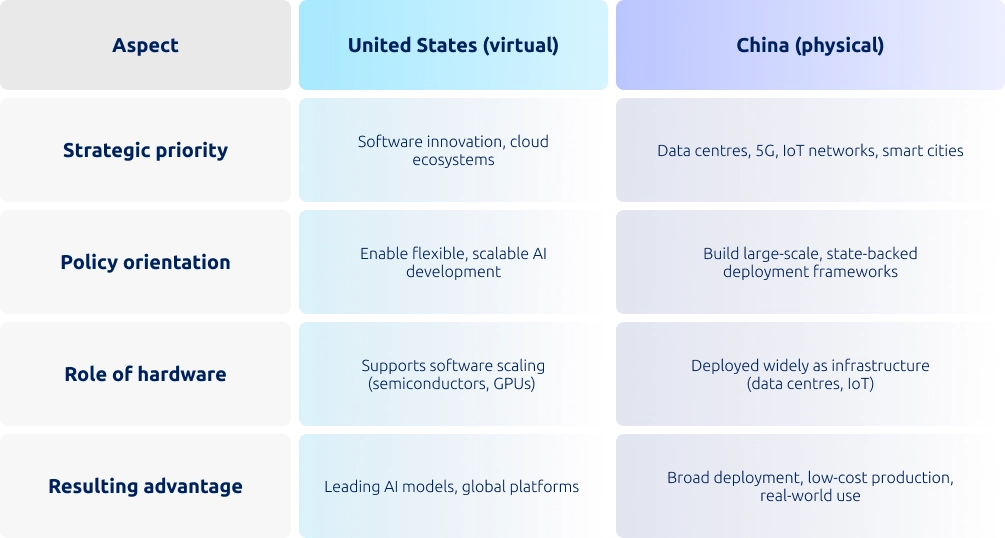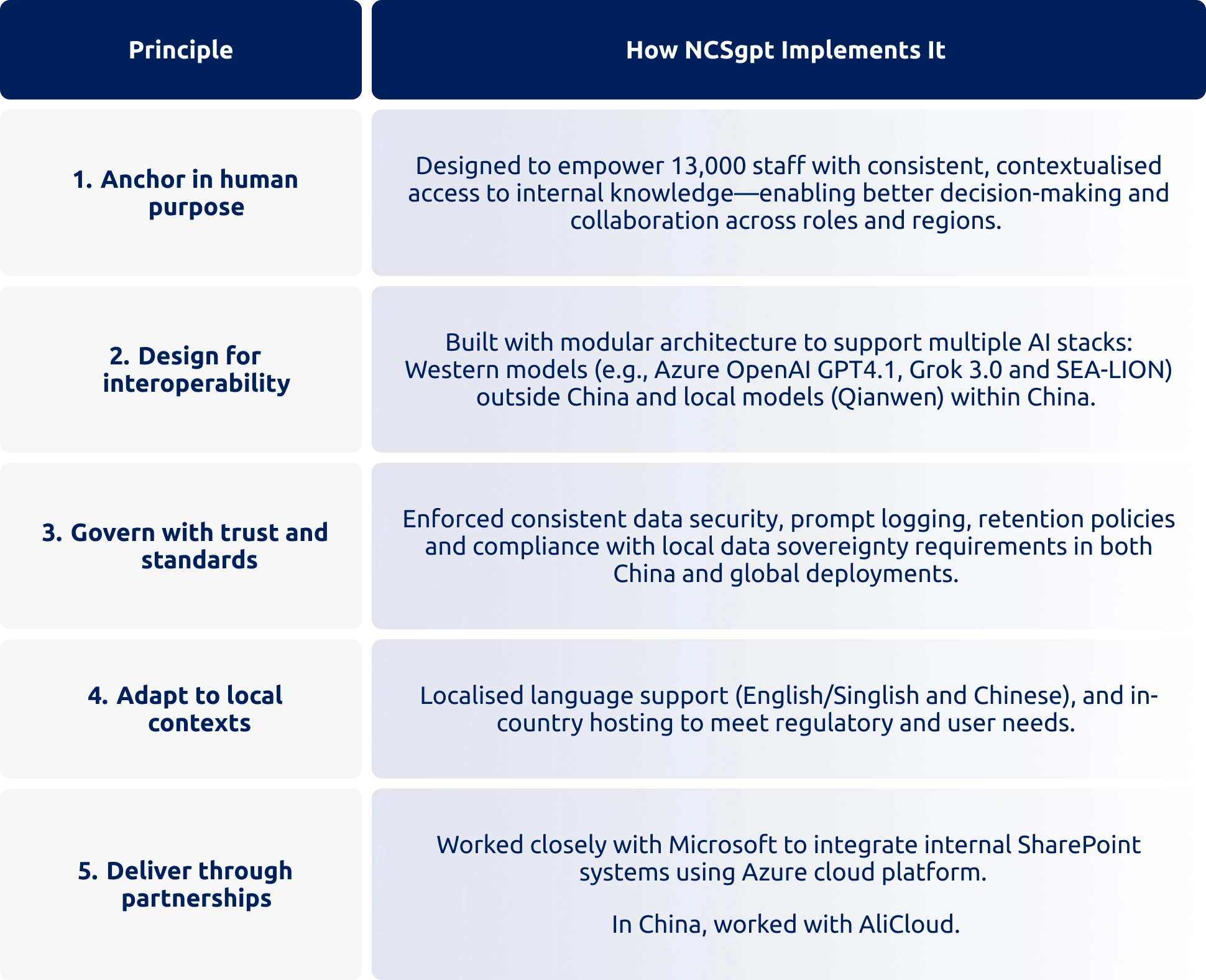Published: Oct 17, 2025
Building collaborative AI in a fragmented world
How enterprises can navigate bifurcated ecosystems and turn fragmentation into a catalyst for innovation
The global AI landscape is diverging rapidly, with the United States and China developing fundamentally different ecosystems—one rooted in virtual software infrastructures, the other in physical, state-backed deployments. Far from signalling the end of collaboration, this fragmentation marks the start of a new chapter where interoperability, adaptability, and trust are more important than ever. For enterprises, especially those across the Asia-Pacific region, the challenge is not whether they can avoid fragmentation, but how they can navigate it effectively while continuing to deliver consistent, secure, and human-centred AI solutions.
Key takeaways
- The global AI landscape is splitting into two main models: a U.S. approach, built on software and cloud platforms, and a Chinese approach, built on physical infrastructure such as 5G, IoT, and smart cities.
- This fragmentation highlights the need for designing AI systems that can operate across multiple platforms and regions.
- Success requires shared standards, trust-based governance, and solutions tailored to local languages, regulations, and user needs.
- Strategic partnerships are crucial for scaling AI solutions and maintaining agility in rapidly evolving markets.
- NCS helps organisations navigate this fragmented world by building adaptable, secure, and human-centred AI solutions that deliver consistent outcomes globally.
A world of divided AI ecosystems
The global AI landscape is no longer moving in a single direction. Instead, it is splitting into two main models:
- United States (virtual ecosystem): A software-driven approach powered by cloud platforms, global developer networks, and semiconductor leadership. This model prioritises flexibility, innovation, and scale.
- China (physical ecosystem): A state-backed, infrastructure-first approach built on investments in 5G, data centres, IoT networks, and smart cities. Software in this model serves large-scale deployment and real-world integration.

Table 1. The U.S and China are prioritising building a different type of AI ecosystem.
This divergence is not just about politics or regulation; it also encompasses broader societal issues. It reflects fundamentally different ways of thinking about how AI should be built and applied. For organisations working across regions, the challenge is clear: you cannot avoid fragmentation, but you can design to succeed within it.
Five principles for navigating fragmentation
Below are five principles that can guide business and technology leaders in turning fragmentation from an obstacle into a catalyst for stronger, more effective AI solutions. These principles are not abstract ideals; they are practical strategies for building AI systems that thrive in a fragmented world.
1. Design for interoperability
There is no single, universal AI stack. Businesses must build AI systems that are modular and portable, capable of integrating with multiple platforms. This reduces the risks of lock-in, helps adapt to regulatory shifts, and ensures service consistency across regions.
2. Govern with trust and standards
Shared governance frameworks are the “infrastructure of trust”. Initiatives like Singapore’s AI Verify Foundation demonstrate how businesses can align with principles of fairness, transparency, and safety. Embedding these standards into AI design and delivery enables organisations to operate consistently across borders.
3. Adapt to local contexts
The Asia-Pacific region exemplifies the complexity of fragmentation, characterised by its diverse languages, regulations, and varying levels of technology maturity. Success depends on treating localisation as a design principle, not an afterthought so that AI can adapt intelligently to user needs while remaining globally portable.
4. Deliver through strategic partnerships
No single vendor can cover every requirement. Instead, businesses need to orchestrate an ecosystem of partners. By collaborating across domains and borders, organisations can scale faster, reduce risk, and stay resilient in changing environments.
Scaling AI together: NCS and our strategic partners

5. Anchor in human purpose
Despite fragmented systems, the shared goal is clear: AI must deliver safe, meaningful, and equitable outcomes. Organisations that put people at the centre, building systems that are trustworthy, inclusive, and beneficial to communities, will be best positioned to thrive.
NCSgpt: A case study for a global workforce
NCSgpt is our in-house, AI-powered assistant that enables over 13,000 staff across multiple geographies to work more effectively, reduce friction in daily tasks, and maintain consistency in how teams collaborate. Launched at the end of April 2025 and continuously enhanced since then, NCSgpt empowers employees to identify, contextualise and leverage internal enterprise knowledge—ranging from delivery methodologies and branding guidelines to procurement and HR policies (NCS, n.d.).
Its primary goal is simple yet transformative: to enable more effective client engagements, solution planning, marketing efforts, and strategic decision-making by making relevant internal knowledge accessible, accurate, and actionable. However, delivering this solution across our entire workforce presented a clear challenge: how to design and deploy a consistent, enterprise-grade AI assistant in a world of bifurcated AI stacks and technology ecosystems?
The solution and delivery team built two versions of NCSgpt based on China and Western technology respectively, but using the same design language to create a standardised user experience. The five principles for navigating fragmentation guided the successful development and delivery of NCSgpts and continues to inform ongoing enhancements.


Figure 1. Some user experience powered by different tech stacks.
The five principles for navigating fragmentation

Table 2. How NCSgpt adheres to the principles.
This approach demonstrates how complexity can be turned into opportunity: by aligning design with principles, businesses can deliver AI solutions that are both globally consistent and locally relevant.
Fragmentation in AI is not the end of collaboration — it is the reason for it.
By designing for interoperability, embedding shared standards, adapting to local contexts, and building through partnerships, businesses can turn complexity into a source of resilience and innovation. The ultimate anchor remains human purpose: creating AI that is safe, inclusive, and meaningful.
At NCS, we help organisations thrive in this environment by building adaptable, secure, and human-centred AI solutions. Drawing on our global ecosystem of partners and deep regional expertise, we deliver consistent outcomes across diverse markets while ensuring compliance with local requirements. Our approach turns fragmented landscapes into opportunities, enabling clients to scale confidently and unlock the full potential of AI.
References
NCS. (n.d.). Everyday productivity powered by AI. Retrieved July 16, 2025, from NCS Impact Insights: https://www.ncs.co/en-sg/impact-insights/intelligentisation/accelerators-and-tools/everyday-productivity-powered-by-ai/
Syed, A. (2024, December). Technological bifurcation in AI: Potential convergences of China-United States parallel global innovation. Spotlight, 42(12), 1-18.
